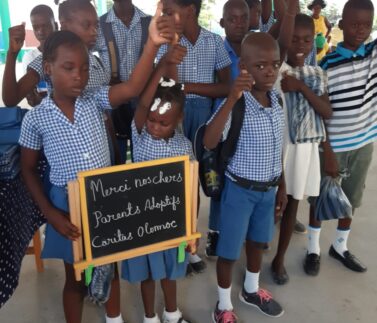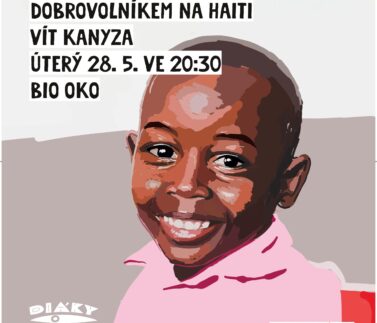
The children of the yeast school set out on a journey to Idonel
Drozdin – Arid Haiti, where the country is shaking, where people live … Yet Haiti still has its joy, people sing, playing football, … Yiddish school children went to the country where their classmate Idonel lives on Tuesday 29th January. What did they learn?
Klára Lőffelmannová, who has been helping under the flag of the Archdiocesan Charity Olomouc three times in Haiti, has invited children to travel to Idonel. Last autumn Klara got up at three o’clock in the morning to get to Prague airport in time. From there she flew by plane to Vienna, then via London to Miami, where she and her colleague slept, and the next day they went to Haiti. The journey took two long days. A picture of a plane appears on the screen in front of the children.
“And that plane, it honked?” wonders one boy.
Klára smiles and shakes her head. “No, it wasn’t, but cars in Haiti honked.”
The children are interested in the language they speak in Haiti and learn that they are French and Creole (in Creole, the languages of the natives brought by slavers from Africa in the past are mixed with French). “If you want, I’ll teach you something,” Klara tells the children.
Her suggestion is well received by a large audience. “Yeah!”
Klára does not hesitate and describes something from the Creole glossary:
“Hello, Salut.
How are you? – Komo ou ye?
The Haitians usually answer: It goes – Pa pi had. ”
And they are in Haiti, the capital of Port au Prince. With the help of photographs, it is mixed between the driver and the pedestrians in the crowded streets. There are so-called tap taps, which you can just wave and they stop – because there is no working timetable at Haiti. Likewise, drivers do not observe any traffic rules. Among the cars sometimes appear animals or street sellers. “The goods are worn on their heads, for example, this lady who sells toothbrushes… And this gentleman sells bags of drinking water, five bags for 5 gourds, which is 2 of our crowns. Drinking water is a major shortage in Haiti,” says Klára.
There are garbage all over the city, because there is no waste system in Haiti, the garbage truck doesn’t go there. Also the coast is dirty from garbage. Only at private beaches someone takes care of it.
“And what the dangerous animals lives there?” asks another student.
Tarantulas and scorpions? Mosquitoes are much more dangerous
According to Klara, large animals such as the tiger or the lion are not prominent in Haiti. “You come across snakes, spiders like tarantulas, or scorpions. However, mosquitoes are the most dangerous because they transmit malaria. Therefore, it is necessary to have an insect repellent and to sleep under the mosquito net,” says Klára.
A typical Haitian dwelling appears on the canvas. It is built of pieces of sheet metal, wood and canvas instead of the roof. These homes are hard to withstand the disasters that are common in Haiti. “Hurricane did not even survive this church in Roche and Bateau two years ago. Hurricane took its roof and destroyed the surroundings. People lost their houses. That is why we have announced a money collection,” Klara comments on another film with a covered church.
“And have you experienced an earthquake?”
Klára nods. “When we returned from Roche and Bateau to Porto, suddenly everything started to shake at dinner. It took about 15 seconds, but a lot of houses could fall over that time… This bricked police station was damaged, too,” shows another photo, noting that the brief tremors have been repeated. The earthquake epicenter was in the north near Tortuga Island, where pirates from the Caribbean were staying.
“Noooo,” the children threaten, apparently cheering for the Caribbean pirates.
The country is shaking often in Haiti, but Klara experienced it for the first-time last fall. It was nothing pleasant.
“And why is this earthquake happening?”
Haiti lies in an area beneath the surface of which occasionally lithospheric plates move. “Last year’s earthquake was the strongest since 2010, when most of the houses in the capital fell, a lot of people died and it was a tragedy. The houses in Haiti are not built from quality material that will last,” explains Caritas workers.
The audience wonders if there is anything to be prepared for. And reportedly not. “I didn’t sleep for many nights. You were always on guard if the strong shocks were repeated. In this case, people should run out of the building or stand up to a pillar or pillar that can stand it. We also considered packing an emergency bag with the most important documents, which in the event of a catastrophe we would simply grab and run,” says Klára.
The children are burning more and more questions, like how many children Haitians have? According to Klára, there are six children per family.
How’s Idonel?
“And does Idonel have siblings?” they reach their classmate.
Klara seems to have no siblings, but it is likely that half-siblings do. This is common in Haiti. “But we know Idonel lives with his parents. His mother doesn’t work and his dad makes charcoal. Originally, Idonel wanted to be a doctor, but he rethought it and now he wants to be a farmer,” says Klára. She met Idonel during her last mission (last fall) in the high school class where she is now studying. He is 18 years old, which means he is of age in Haiti.
The expedition reaches the elementary school of the sisters of St. Joseph in Gonaïves. The pupils are dressed in uniforms and the girls have hair full of various bows, beads and ornaments. The children wonder what would happen if the young Haitians lost their uniform or forgot it? What if they were late for class?
When the children arrive late, they are unlucky. They are not allowed to enter the class, so they must be punctual. Inside the school, Haitian children cannot also, unless they are dressed in uniform. That is the rule. “It is a problem, so many Haitians cannot afford to send children to school because they do not have money for uniform, tuition, examination fees,” explains Klara, saying that all children attending Gonaïv school are sponsored. They are really the poorest.
The next question will be played. “And are there rich people?”
A large bag of rice swallows the teacher’s monthly salary
“Yes, there are a few very rich people in Haiti. For example, government ministers or business owners live in Porto villas. There are also supermarkets in the rich neighborhoods where they can shop … But in Haiti, the vast majority of the very poor people who live on food. There are only very poor and very rich, nothing in between here in the Czech Republic,” says Klára, giving an example of life when, for example, a Haitian teacher buys one big bag of rice for his monthly salary (which lasts for one month) but he has no money left for housing, new pants,…
Thanks to Distance Adoption (schools in Roche and Bate, Gonaïves and Baie de Henne), children also eat at school. Many of them do not even have hot food at home. At school, they eat rice and beans every day in a variety of culinary variations. Bean rice is the most common food in Haiti – it is saturated and cheap. “At the school in Gonaïves, the nurses give their children milk before they start school. This is good because the children were dehydrated, hungry and could not concentrate on teaching, some fainting,” continues Klára.
“And how are they there?” asks a little girl.
The journey ends with Klara’s optimistic words: “Pa pi mal – it goes. They are poor, but they can enjoy life, they are happy with their family. I think they are brave.”
An inscription appears on the screen: See you soon, Idonel! It’s time to land the plane. We are back in Drozdin, inside the building is warm, some children are heading for lunch, others home (the end of lessons) and behind the windows is snow and cold…
We thank the yeast pupils and their teachers there for their attention and also for helping to improve the life of Idonel. Thanks to their support, he has a chance for the future.
Karolína Opatřilová, Archdiocesan Charity Olomouc



